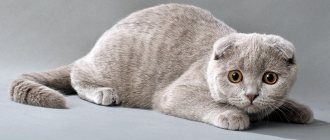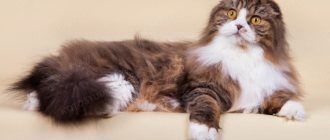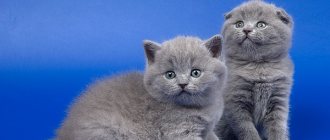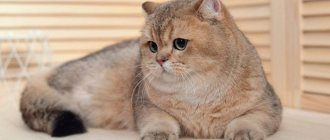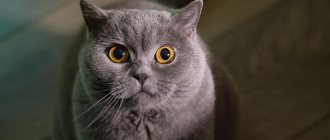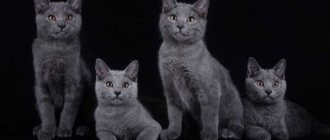Origin of the shorthaired breed
As you might guess, the British straight-eared cat first became known on British territory. Those interested in it often have questions about the age of the breed. The fact is that no one had previously been particularly involved in describing the origin of breeds. Stud book records arose much later. To illustrate this statement, it is enough to say that the breed received a standard and pedigree only at the very end of the century before last, namely in 1898.
However, there is some information about when to start counting the breed. Researchers suggest, and not without reason, that the age of this wonderful breed is similar to the age of the Roman Empire! Where did such information about the origin come from if there were no stud books? It's time to turn to ancient images of that period. On them you can see cats that are strikingly similar to modern representatives of the British breed.
IMPORTANT: By the way, initially this cat was short-haired.
It is possible that it was precisely this short, tightly knit coat that the breed reached such an impressive age. The cat was given the opportunity to survive in any conditions. In addition, the cover helped the ancient representatives of the breed to always look quite representative. The gray color of the plush fur is exactly the universal color that most owners like.
In addition to the color and texture of the coat, the breed attracted such characteristics as endurance and enviable physical strength. The British cat is developed, has a massive back and shoulders. Quite muscular legs can also be considered a feature. As a result, the weight of representatives of the breed is rather large - from 5 to 8 kg with a height of 9-14 cm. What is unique is that with such height and weight, the breed managed to look quite harmonious and move gracefully.
It is quite natural that such a hardy, physically developed cat found a place among Roman sailors. They gladly took animals with them - this is how it was around the 2nd century BC. The breed appeared on British lands. Graceful animals with a mysterious gray color immediately fell in love with local residents. This color is also called blue. Even today it is very popular, and many centuries ago, according to surviving information, it was the only option.
In many ways, the age of the short-haired breed is so impressive because its representatives brought by the Romans crossed not only with each other, but also with wild cats. Given the isolation of the area, the breed concentrated on the islands, acquiring resistance to the legendary British rainy and windy climate. Which, of course, is a huge advantage when kept in our latitudes.
Character
British cats are incredibly friendly. They are calm and balanced. Fold-eared cats are not at all characterized by emotional swings and typical cat hysteria. They do not show aggression and always “maintain neutrality.” Fold cats have a stable character.
These cats are especially attached to the house and owner. The British Fold cat easily becomes attached to a person, is friendly with everyone, carefully monitors the mood of its owners and adapts to it. They are loyal but not intrusive. The British will never deliberately attract the attention of the owner, distract him from business, jump on his lap or play pranks in any other way, since they are above such behavior. Typical representatives of the English aristocracy.
If you need a smart, picky cat, then the British Fold is the perfect find! These animals are easy to train with basic training. It will not be difficult to accustom them to a tray or scratching post. These pets learn the rules of living in the house on the fly. Fold-eared kittens can even be weaned from climbing curtains. However, the owner of a representative of this breed must remember that unreasonable aggression and rudeness on his part can intimidate the animal, then the British Fold cat will begin to be afraid of people or show aggression.
Features of behavior
- Often representatives of this breed take a “column” position - they sit on their hind legs and straighten their back. It may seem like this is a British Fold cat posing for a photo, but in fact the reason lies in the physiological structure. This stance is necessary to stretch the spine.
- The British are very fond of small children and elderly people. Also, the presence of other animals in the house, including dogs, is not a problem for them. Folds get along well with everyone. Since they live quietly with dogs, these two pets often live in the same house together.
- Most British Folds are afraid of heights. This is explained by the specifics of the vestibular apparatus. Therefore, the owner of this cat does not have to worry about it jumping from the cabinet to the table, etc.
Myths about the character and behavior of British cats
Now that we’ve sorted out the history, it’s time to debunk some of the myths that surround the breed:
- “No sentimentality!” - the whole appearance of the animal seems to speak. Some people think that such a cat is extremely independent, willful and serves as the perfect embodiment of the “cat that walks on its own.” This is partly true: for example, a straight-eared pet cannot stand it when they suddenly pick it up and start touching it. However, if you count how many smaller brothers do not like such liberties, it becomes clear that in this regard there is little that distinguishes the British from the rest. But when the mood is conducive to tenderness, the animal itself will come to communicate. Moreover, both kittens of several months old and older individuals are not averse to purring and rubbing against the owner.
- “I don’t care what’s going on with you,” that’s what the expression on his plush face sometimes says. In fact, no matter how much indifference she expresses, the animal quickly distinguishes a favorable home atmosphere from an unfavorable one. Frequent showdowns, the constant presence of noisy companies - all this will greatly disturb the pet.
- Complex character - this description, ironically, is often given to a cat by owners who have small children. People are perplexed why this animal, famous for its balance, begins to bite and hiss. It's not just about character. It’s just that the breed doesn’t adapt well to those families where there’s a lot of fuss. Even a cat’s advanced age, during which he has seen a lot of things, will not save him from stress when a noisy child appears in the family.
- Such cats can often be left alone at home - under no circumstances! Both a kitten, which is barely a month old, and an adult pet do not tolerate long periods of being alone. Animals very quickly begin to get bored and wait for their owners to return. You especially need to devote a lot of time to a cat who is only a few months old. Talking and stroking are not just desirable, but necessary!
Basic character traits
Let's talk about the main character traits that the breed actually demonstrates:
- Independence is a characteristic that has given rise to some of the myths described above. Despite the fact that in reality the Briton is very attached to his owners and loves to communicate with them, he is extremely proud. You could say he has a truly British sense of dignity.
- No way in the world would he show weakness. By the way, this is a huge plus, since regardless of age, the cat is unlikely to behave inappropriately - for example, ruin the owners’ shoes or wallpaper.
- Patience - thanks to this character advantage, a cat can easily get along with other pets and people. The Briton will not become violently offended over trifles, which makes him quite accommodating. But, of course, such behavior extends only to the limits of reason - if necessary, an aristocrat can fight back.
- Curiosity - age is not a limiter in this regard. Both kittens and adult animals enjoy exploring the world. By the way, with this feature it is very easy to find a common language with your pet. If you constantly communicate with him, of course.
- Friendliness - the breed is unique in that, unlike most representatives of the cat family, it is not inclined to single out one owner. She is equally friendly to everyone . Even to guests.
- Intelligence - the short-haired aristocrat will always understand what is required of him. Whether he will fulfill it is another question, but he will always understand.
- Excellent Parent – British people are widely described as making excellent parents. It is believed that before the baby reaches 4 months, it is impossible to separate him from his mother. It will be equally painful for both. British women usually make very sensitive, caring mothers, and their offspring make obedient children.
Features of behavior
The characteristics of the British determine their habits and habits. Let's look at the behavior in basic terms.
Devotion
We are accustomed to the fact that the palm in loyalty belongs to dogs. According to prevailing stereotypes, it is difficult to imagine such a quality in a cat. Cats are self-sufficient, they are born with this feeling. Since the times of Ancient Egypt, it has been known that cats are connected with the afterlife and bring their special energy into the house. Watch the video, it presents some of the character traits of the British cat breed.
They love to clean the energy field, align it with their owner, and protect the territory from negative energy influences. The British will only be faithful to someone who gives her a lot of positive emotions, plays with them and expresses his love for them.
Patience
This is one of the defining character traits of British cats. They tolerate everything from small children. Little children love to explore the world, touch, stroke, pull the tail and whiskers, and do a lot of unpleasant things to the poor cat. But they steadfastly endure all these medieval tortures, realizing that the child is too small and simply does not understand that an animal can be in pain.
Friendliness
Friendliness is one of the main traits of this breed. They can be friends with everyone. At an early age, they love to play a lot and are active; they can hit someone with their paw while playing. Growing up, they are friends with cats and dogs in equal measure.
Cleanliness
A high degree of cleanliness sets the British apart from the entire cat family. They quickly become accustomed to the litter tray, adopt good manners and lick themselves very thoroughly. Their coat is always clean and tidy, as if they take care of their appearance. By licking themselves, they relieve stress.
Stubbornness
The British will not follow your orders unquestioningly. If they are busy with something, they will not tear themselves away from what they are doing for nothing. They do not tolerate orders, no matter what you say and in what tone.
Favorite habits of representatives of the British breed
It's time to talk about the favorite habits that a short-haired plush pet is prone to:
- Sleeping a lot is almost the main habit. Even if we are talking about an adult cat who will no longer grow. Therefore, if there is a British person living in the house who has been dreaming for 20 hours in a row, there is no need to panic. How to wake up. The animal will wake up extremely irritated and unkind.
- Throwing objects on the floor - future owners should be prepared for the fact that such a habit is not uncommon among an aristocrat. The choice is as follows: catch fragile things or immediately stop hooliganism. Considering that the behavior is dictated by simple curiosity, you can satisfy it by giving your pet a tumbler toy.
- Searching bags is another habit that results from insatiable curiosity. The mustachioed customs officer will be happy to thoroughly examine the contents of both shopping bags and guests' bags. Therefore, you should immediately place them out of reach of your pet.
Features of the variety
It is impossible to say with certainty that the British cat breed was bred in England. According to one of the legends, the short-haired variety was widespread in the territory of Ancient Rome, from where it came to Europe by ship, and then to England itself. These kind and affectionate animals are distinguished by a calm, easy-going disposition; they will never demand too much attention from their owner, easily tolerate changes in environment, and do not get bored alone if the owner is away from home for a long time on business.
Having studied the characteristics and description of this breed, you can understand that such a pet is suitable for a family with children. The animal leads a measured lifestyle, never shows aggression, accepts and follows the main rules of the family, and will willingly play with a small child, whom the cat treats with special warmth.
